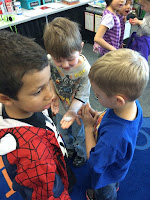Writing:
In writing for Unit 3 of Journeys, students were learning about informational writing. We began the unit learning the difference between facts and opinions. After several shared writing opportunities together as a class, students began informational writing with a picture of an animal. They worked together with a partner to list as many facts as they could gather from the picture into a graphic organizer. After completing the graphic organizer, they used these facts to create an information writing to share with the class about the animal they were given. (Each picture had a number on the back. Students drew out a stick with one number and that was the animal they got. This eliminated any hard feelings.) The kids loved this activity!
Science:
The Minnesota Science Standards that were covered with this unit were:
1.4.1.1.1 Describe and sort animals into groups in many ways, according to their physical characteristics and behaviors.
1.4.2.1.1 Recognize that animals need space, water, food, shelter, and air.
1.4.2.1.2 Describe ways in which an animal's habitat provides for its basic needs.
WEEK 1
Day 1:
On day one of science, students took a pre-test to help me gauge what they already knew. We started the unit by reviewing wants and needs of humans taught back in December. Students created a T-chart in their science journal and filled in the human needs side. Next we watched a short video clip about animal needs and added the information learned to the other side of the T-chart. At the end of the lesson, we used the T-chart to help compare and contrast the needs of people and animals. Students figured out the only difference was clothing for people and not for animals. This sparked a conversation about why we need clothes, but animals do not. Each student made a prediction of what they thought was the reason.
Day 2:
During the second day of the unit, students learned about the five different animal groups and their body coverings. First, we looked through a powerpoint explaining each type of animal; mammals, birds, fish, amphibians, and reptiles.
We added each category into our science journals and gave a small description of each group. Then students added pictures of animals that fit in each group and wrote in other examples we came up with as a class. Last, we discussed why animals have the coverings they do for the habitat/animal group that they are in. (Our reading curriculum had a story about animal groups that helped to reinforce these skills and give more information.)
Day 3:
We began our research project on day three which included reading, writing, science, and technology. At the beginning of the lesson, students did a Think-Pair-Share to make a prediction and discuss what habitats are. We discussed their ideas and watched a short video clip explaining what habitats are. https://www.youtube.com/watch?v=r_4PKCxu6ks (This link is to a great Real World Science Video that I used throughout the unit. We only watched the first 2:20 for an into to habitats.)
After watching the video, we added the vocabulary word habitats into our journals with a definition.
Then, students were given the opportunity to look through many non-fiction books about animals and habitats. While they looked through the books, they were getting ideas of animals they could do their research project on. Once students had enough time to look through books, we brainstormed a list of animals that live in many habitats. Each student was able to pick one of the animals from the list or another one they saw in the books to research and teach the class about.
After selected an animal, each student wrote to tell what they already knew about their animal. (I have attached a resource at the bottom.)
Day 4:
On Friday afternoon, one of the fourth grade classes came to our classroom to help each student research information about their selected animal. We used two internet sources for research:
The San Diego Zoo website was a great resource because the information was easy to understand, it included pictures and video, and there is a live Webcam for students to look at the animal. Not every animal could be found on this website. Students filled out a graphic organizer as their fourth grade buddy helped them research certain information about the animals.
WEEK 2
Science:
During Science in the second week, students learned about each of the habitats.
Each day, I taught students about two new habitats. We began each day by watching a video clip about the habitats.
After watching the short video clips, students filled out a graphic organizer of information that was glued into our science journal at the end of each lesson.
The habitats that were learned about each day either had similarities or differences that were discussed after learning about each of the habitats. On the first day, we learned about the Polar and Desert. On the second day, they learned about the Grasslands. On the third day, they learned about the forest and rain forest. On the fourth day, they learned about the ocean and ponds.
Writing:
For writing this week, students used the information they had researched last Friday with fourth graders to write an informational writing about the animal of their choice. In the writing, they needed to include the color, body covering, special markings, weight/height, food it eats, where it lives, and two fun facts about the animal. First they wrote a rough draft using the outline of researched information. After completing the outline, students edited their writing with me and wrote a final draft.
Art:
On Friday, students completed an animal art project to go with their informative writings. They were each given a picture of their animal cut in half. Students glued one half of the picture to a sheet of white paper and began to draw the other half of the animal. We talked about proportion of the animal to make it look like the other half of its body. Some were symmetrical pictures and others were not. After drawing the outline, students colored in the picture using oil pastels. They turned out amazing! Below are the pictures of some completed projects.
WEEK 3
Science:
During the last week of the unit, students were able to present their animal facts to the rest of the class. We put their art project up on the projector for the class to look at while they were teaching about their animals. It was great to see these first graders teaching each other new information about the animal they spent so much time researching.
As students taught each other about the animals, they had to decide what animal group and habitat each animal fit into. (The animal group page looked the exact same and was on the other side of this page.)
After all presentations were complete, we played a review Jeopardy game that included all of the information the was taught over three weeks.
At the end of the week, students took the post-test and sorted animals into the habitats where they belonged. It was fun to see how much the students had learned during the three weeks. The projects are hung in the hallway and get comments frequently as students stop to look at the work.
Writing:
During writing in the third week, students learned about writing letters to inform someone of some information. We used this opportunity to write a letter to someone at home giving facts about one of the habitats learned. Students were able to use their journals to help remember facts about the habitat. We first learned about parts of a letter and created an anchor chart that students could use if needed while writing their letters. Each of the writing completed were assessed using two different writing rubrics created.
Language Arts:
The main story of the week in our reading curriculum this week was called Animal Groups. After reading the story together as a class and with a partner, we spent time comparing and contrasting the different animal groups. This was the skill of the week. On Friday, students were put into small groups. Each group was given a venn diagram with two animal groups listed. They had to compare and contrast the two groups. If needed, they could use their books to gather information. Each group was given 10 minutes. When the timer went off, they switched papers and added any information that was missed. They compared all groups by the end of the lesson. (Below is an example)
Resources for Habitat Unit

























































